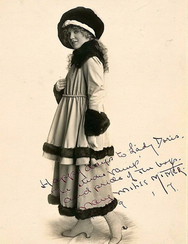The Feed: @allaboutsilentfilm
- FLAPPER PRESS
- Dec 1, 2020
- 8 min read
Updated: Sep 2, 2022
By Elizabeth Gracen:

If you have an Instagram account, you've seen the sheer variety of content created by people from all walks of life from all across the world. Being a visual person, it is my favorite social media platform, and I'm constantly coming across a fascinating feed that captures my imagination. THE FEED is our newest series on Flapper Press and features curators and their approach to creating unique Instagram feeds.
This month, I reached out to the creator of @allaboutsilentfilm.
EG: Thank you so much being part of this new series on FlapperPress.com. Wow! The images in your feed are just gorgeous. Mesmerizing faces. Magical photography. Please tell our readers a little bit about yourself and why you’ve chosen to curate the history of silent film.
Grace: First of all, thank you so very much for letting me be a part of your blog! I am so very honored! So, a little about myself! I’m seventeen years old, I live in Minnesota with my parents, my brothers, and my two cats. I’m a senior in high school, and some of my hobbies include spending time with friends, writing, and watching old movies! I have loved Old Hollywood since I was little, but my love for silent film didn’t start until about 2 years ago. My mom introduced me to silent film actress Olive Thomas because she was mentioned in a podcast. As soon as my mom informed me about Thomas, I was truly captivated! Essentially, the reason why I have this silent film page is to enlighten others on the beauty of silent film. It is very overlooked, not many know about it. I want my job to be to inform others on the true beauty of silent film!

EG: As a film buff, I’ve always been drawn to old black-and-white films. When I look at the faces and photography from the silent and early film eras, it just feels so much more magical than the contemporary films of today. Granted, there are gorgeously shot films (Phantom Thread makes me crazy—it’s so beautiful), but nothing really compares to these early ones. Do you think that we’ve lost some of that magic in film as time has gone on and technology has developed? Do you have an opinion about the contemporary controversy about shooting on film stock vs. digital?
Grace: To some extent, I do think that we’ve lost some magic in film as time has gone. I think it’s because with silent film, film techniques were new. They were fresh, innovative; no one had ever seen them before. An example can be a film that was colored. One of the first silent films in color was 1922's The Toll of the Sea. When one watches this film, the color is truly mesmerizing when you think that this feature was incredibly new at that time, and the color itself is simply beautiful. Essentially, we’ve lost magic in that sense because nearly every movie now is in color. Therefore, it's not new, it's not innovative, it's the same old same old. In regards to film stock vs. digital, I don’t have a specific opinion on which one I prefer. Digital cameras inhabit higher resolution, as well as the ability to speed up film. But I honestly don’t know. Because I have a love for silent film, which used film stock; I don’t prefer one over the other. I believe they’re equally good.

EG: How much time do you devote to your Instagram feed? Are you a history buff in general when it comes to researching and curating your images?
Grace: I spend about 2–3 hours a day dedicated to my Instagram feed. This includes my research, posting, as well as liking and re-sharing from other people’s feeds. I am 100% a history buff! Obviously, I find silent films incredibly interesting, and I love doing my research. Whilst doing my research, I happen to become fully immersed in the content I’m researching, whether that be a film or a specific actor. In regards to the images, I become captivated with them as well. Firstly, I love the 1910s–1920s fashion style. From the ringlets to the bobs to the straight-line dresses; it's all so beautiful, and that beauty shines through the photos.
EG: What do you learn from the photographs and clips that you curate for your account? What can we all learn from them?
Grace: Oh, I learn lots. I continue to learn about the specific acting choices made at the time. Because films at that time were silent, actors didn’t have their voices to act. Instead, they relied heavily on their facial expressions and their body movements. Therefore, when I watch silent films, I still learn about how actors approach acting in different ways. I learn lots of things, but the manner in which specific actors approach acting is definitely the most significant thing I’ve learned. What I want my audience to learn is just that, how actors actually acted.

EG: Do you think it’s important to understand the history of film?
Grace: I definitely think it's important to understand the history of film! Silent film, especially, because it's the foundation of cinema. It was the beginning of movies, so that in itself is an important reason why one should understand the history of film. Another reason is that silent film is so incredibly different from films today, I think it's important for people now to appreciate film history. We can learn from silent films, with the lack of dialogue and the innovative film techniques. There’s an abundance of things that people can learn about film.
EG: Finally, do you care if people “follow” or “like” what you are posting? Would you keep doing it even if no one responded? Why do you like engaging in social media? Are you active on other platforms?
Grace: Of course, I want to gain a large audience and to enlighten more people on silent film. But at the end of the day, the amount of views or likes or followers doesn’t matter that much to me. What matters is that the people who are active on my page appreciate and love and support what I do. That's what matters. I would rather have 500 appreciative and supportive followers than 50,000 who don’t care as much. I want to make sure that the people who follow me really care about what I do. I made this account to enlighten others on a lost art, not to get a million followers. My page @allaboutsilentfilm on Instagram is the only platform I’m active on.
EG: Thank you so much for sharing your story and your passion for silent film. Please tell me about some of your favorite curated posts on @allaboutsilentfilm.
Grace: On my post from November 3, 2020, I curated a couple images about the 1927 film The Lodger : A Story of the London Fog. I truly love this film, and I wrote a little review of the film in this post. I curated images and I included snippets from the film. These images and snippets, I believe, captured the great ambiance of the film.
Instagram: “The Lodger,” 1927 is one of my favorite silent thrillers. Visually, it’s a beautiful movie. The cinematography is just excellent; there’s great contrast with the lightness and darkness of the scenes. Also, there’s amazing detail in the title cards, as you can see on the 4th slide. The story is simple, yet it’s original and executed so well. But perhaps, my favorite aspect of the film was the acting. Every actor, whether they were in a main role or just a background character, was great! They were all fully immersed in the story. I was truly captivated by Ivor Novello’s performance. His portrayal of a sensitive and mysterious person was so genuine. There was so much emotion in his eyes alone, it was amazing to see. June Tripp, the actress who played Daisy, was great as well. She was very convincing as a playful and compassionate character. I really love this film. Everything about it keeps the audience fascinated and wanting to know what will happen next. This film is free to watch on ok.ru
On my post from September 7, 2020, I curated 10 images of actresses that showcased them wearing bobbed hairstyles. I love the hairstyles of the 1920s, and I wanted to do a specific post acknowledging them. I tried to include lots of different styles of bobs, ensuring diversity in that aspect.
(Left to Right): Esther Ralston, Renee Adorée, Sally O’Neil, Alice Joyce, Phyllis Haver, Jean Acker, Pola Negri, Virginia Valli, Helen Hayes, Justine Johnstone
On my post from August 6, 2020, I curated a few images depicting Dorothy Sebastian, Joan Crawford, and Anita Page for the 1928 film Our Dancing Daughters. I love this film very much, and I wanted to make a post about them. These images really captured my attention because of the beautiful dresses and the beautiful actresses in the photos.
Instagram: Dorothy Sebastian, Joan Crawford and Anita Page in the 1928 film, “Our Dancing Daughters.” A flapper who's secretly a good girl and a gold digging floozy masquerading as an ingénue both vie for the hand of a millionaire. This film was a huge success for MGM, it only cost around $180,000 to make yet it earned $1.1M at the box office (due to inflation, about $15 million today). It was this film that made Joan a star.
On my post from July 26, 2020, I curated an image of Madame E. Toussaint Welcome, a black filmmaker of the silent era. It's incredibly important to include silent film actors/filmmakers of different races, and once I discovered Toussaint Welcome whilst doing research, I knew I had to include her photo and her story on my page.
Instagram: Madame E. Toussaint Welcome was one of, if not the only, female black filmmaker of the silent film era. She was born Jane Louise Van Der Zee on January 10th, 1885 in Lenox, Massachusetts. She attended Lenox High School and took private art and music lessons in Pittsfield, Massachusetts. In her early 20s, she moved to New York with her father and brothers, one of which was James Van Der Zee, who became a famous photographer. There, she married Ernest Touissant Welcome, an entrepreneur, in 1910. Together, they established the Touissant Conservatory of Art and Music. The conservatory was numerously mentioned in the NAACP’s official magazine “The Crisis.” With the advent of film, Madame and her husband made a film that recognized the African-American soldiers of WW1. Under the name “The Touissant Motion Picture Exchange,” Madame and her husband made, “Doing Their Bit,” 1916, which was a twelve-part series shot in a manner of a documentary. She also published the book, “A Pictorial History: The Negro in the Great World War; 1917-1918,” including pictures, paintings, newspaper clippings, and poetry regarding black soldiers of WW1. Madame, being an avid painter as well, painted many oil paintings, including the painting on the second slide, entitled “San Francisco Exposition.” There is not much information about Madame and her husband’s work or lives after WW1 ended. Ernest passed away sometime in the 1940s, and Madame passed away in 1956, and her brother James took over as owner of the conservatory. Unfortunately, “Doing Their Bit,” is presumed lost, which is such a shame, but we must have hope it will be re-discovered someday. I would love to read a more extensive biography on her life; incredibly revolutionary for her time.
On my post from June 8, 2020, I curated 10 images of actresses in lovely outfits. Similar to what I said regarding the bob photos; I love the fashion of the 1920s! Thus, I made sure to include these lovely outfits on my page, and made sure to incorporate different kinds of outfits.
Louise Brooks, Lya De Putti, Evelyn Brent, Janet Gaynor, Edna Purviance, Dorothy Sebastian, Jetta Goudal, Anita Stewart, Josephine Baker, Mary Miles Minter
EG: Please tell our readers anything that you have coming up or would like to promote.
Grace: I don’t have anything to promote, but once I reach 30,000 followers, I will do a Live Stream; a Live Q&A of some sorts! Whenever I reach a milestone follower count, I do a Live Q&A! Other than that, I don’t have anything specific coming up!
Stay tuned for the next installment of THE FEED!
Elizabeth Gracen is the owner of Flapper Press & Flapper Films.




































































